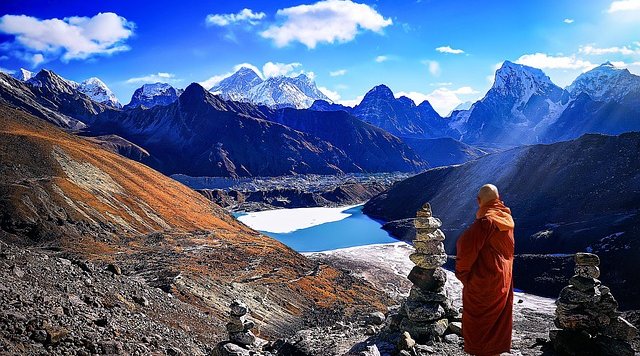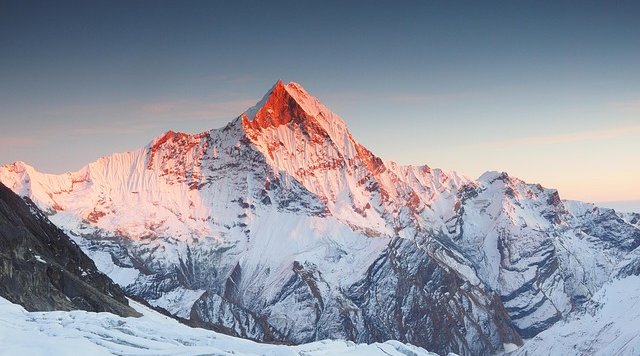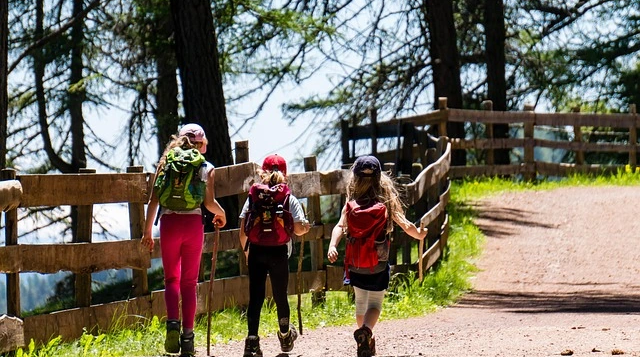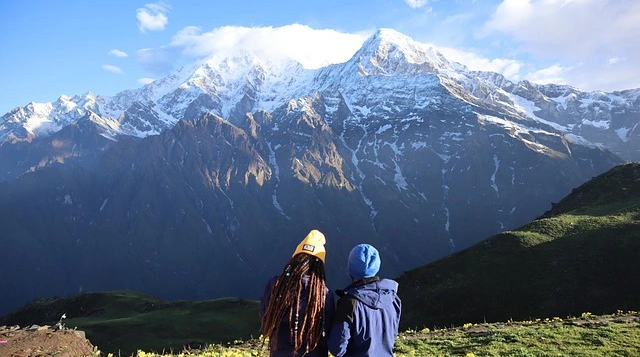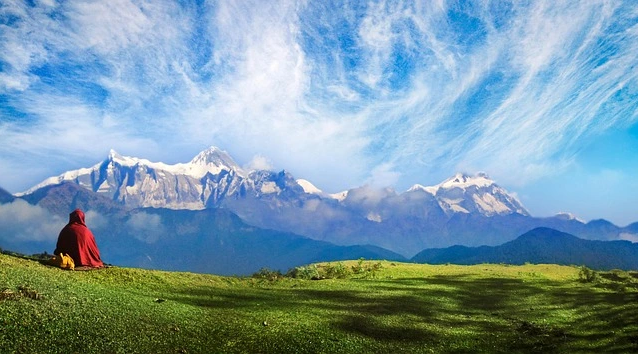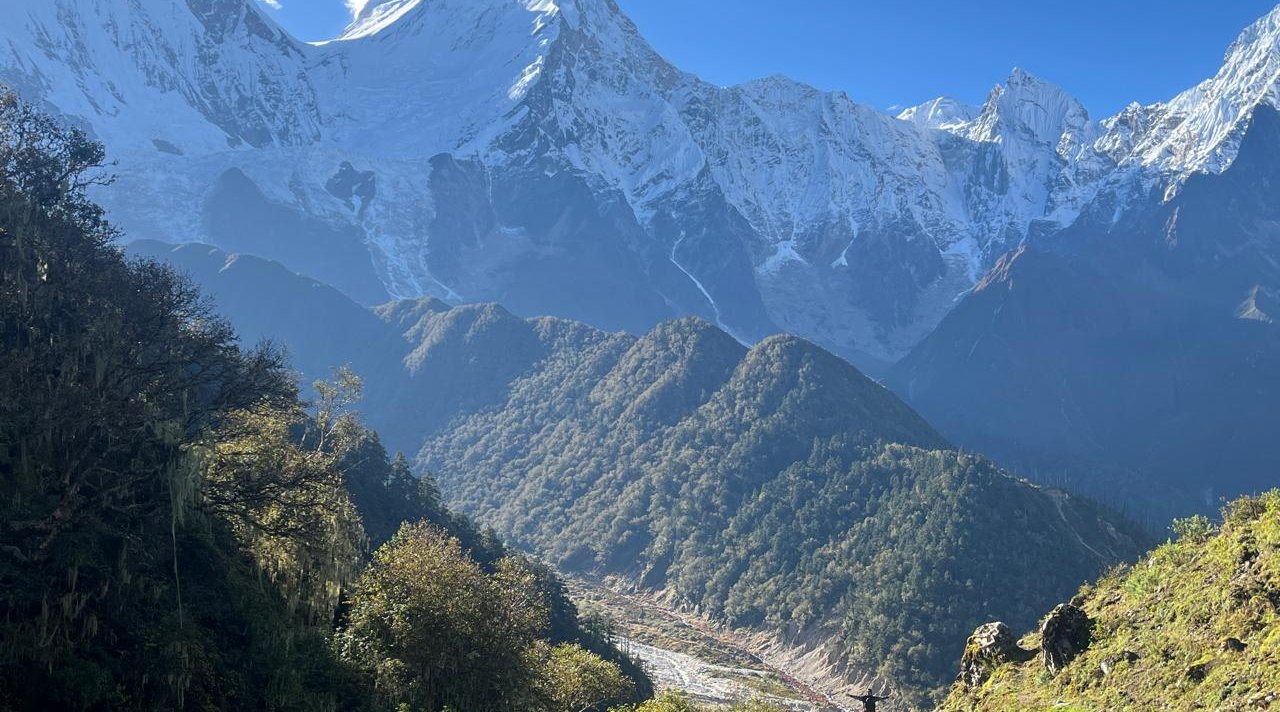Sir Edmund Hillary once declared that Pikey Peak offered the best view of Mount Everest he had ever seen, transforming this hidden trail in Nepal into one of the country's most underrated trekking destinations. This comprehensive Pikey Peak trek itinerary reveals everything you need for planning your 11-day adventure through the Lower Solukhumbu region, from detailed daily breakdowns to insider tips only seasoned guides know.
Whether you're a first-time trekker or experienced hiker, this guide provides practical information about timing, difficulty, costs, and cultural experiences that make the Pikey Peak trek in Nepal an extraordinary alternative to crowded mainstream routes. Let's explore why this moderate-altitude journey might be the smartest trekking choice you'll make in Nepal.
What is Pikey Peak Trek: Nepal's Hidden Gem
The Pikey Peak trek in Nepal takes you to a 4,065-meter summit in the Solukhumbu trekking region, offering what many consider the finest Everest viewpoint trek accessible without extreme altitude challenges. Located in the Lower Everest region trek, this trail winds through pristine Sherpa villages, ancient Buddhist monasteries, and rhododendron forests that burst into spectacular bloom each spring.
What sets this Himalayan sunrise trek apart is its perfect combination of accessibility and authenticity. You'll experience genuine Sherpa culture trek moments in villages where traditional life continues unchanged, far from the commercialization affecting busier trails.
Key Highlights of Pikey Peak Trek:
- Unmatched mountain views - See Everest, Makalu, Kanchenjunga, Lhotse, and Annapurna ranges
- Cultural authenticity - Visit working monasteries and traditional Sherpa villages
- Moderate difficulty - Achievable for beginners with basic fitness
- Budget-friendly - Costs 60-70% less than the Everest Base Camp trek
- Flexible duration - Can be completed in 5-11 days, depending on preference
- Year-round accessibility - Multiple seasons offer different but equally stunning experiences
- Lower altitude - Maximum 4,065m reduces altitude sickness risks significantly
Unlike the Pikey Peak vs Everest Base Camp comparison, this trek doesn't require extensive acclimatization or extreme fitness levels. The trail passes through the Solu region, historically significant as the original homeland of the Sherpa people before they migrated to the Khumbu valley.
Complete 11-Day Pikey Peak Trek Itinerary
This comprehensive Pikey Peak trek 11-day itinerary provides optimal acclimatization while allowing time to explore cultural sites and capture stunning photography. Each day builds gradually toward the summit, ensuring safety and enjoyment throughout your journey.
Day 1: Kathmandu to Dhap (2,850m)
- Distance: 240km drive, 8-9 hours
- Highlights: Scenic journey through terraced hills, first mountain glimpses
- Accommodation: Basic lodge in Dhap village
The adventure begins with an early morning departure from Kathmandu, winding through the Himalayan foothills. You'll pass through Bhaktapur's medieval architecture and climb steadily toward the mountains.
Day 2: Dhap to Sigane (2,960m)
- Trekking time: 5-6 hours
- Distance: 12km
- Highlights: First day on trail, acclimatization walk, local villages
Your first trekking day starts gently through terraced fields and small settlements. The trail gradually ascends through pine forests, helping your body adjust to trekking rhythm.
Day 3: Sigane to Jhapre (2,920m)
- Trekking time: 6-7 hours
- Distance: 14km
- Highlights: Ridge walking, first major mountain views, Sherpa villages
Today's trail follows ancient trade routes between villages, offering spectacular views of Numbur Himal. You'll pass through authentic settlements where traditional architecture remains intact.
Day 4: Jhapre to Pikey Base Camp (3,640m)
- Trekking time: 5-6 hours
- Distance: 10km
- Highlights: Rhododendron forests, dramatic altitude gain, sunset views
The trail climbs steadily through dense rhododendron forest trekking zones that explode with color in spring. Evening offers stunning sunset views over the Himalayan range from base camp.
Day 5: Summit Day - Pikey Peak (4,065m) and Return to Base Camp
- Trekking time: 4-5 hours round trip
- Distance: 6km
- Highlights: Sunrise summit, 360-degree mountain panorama
Pre-dawn start at 3 AM leads to the summit for spectacular sunrise views. The Pikey Peak altitude of 4,065m provides unobstructed views of five eight-thousander peaks.
Day 6: Base Camp to Jase Bhanjyang (3,550m)
- Trekking time: 4-5 hours
- Distance: 8km
- Highlights: Alpine meadows, yak pastures, mountain vistas
Descend through different ecological zones with changing vegetation and landscapes. The trail offers continuous mountain views while gradually losing altitude.
Day 7: Jase Bhanjyang to Junbesi (2,700m)
- Trekking time: 5-6 hours
- Distance: 12km
- Highlights: Thupten Choling Monastery, traditional villages
Visit the famous Buddhist monastery trek highlight at Thupten Choling. This active monastery houses 300 monks and offers insights into Buddhist practices.
Day 8: Rest Day in Junbesi
- Activities: Monastery visits, village exploration, acclimatization
- Optional: Short hikes to viewpoints
- Cultural experiences: Local market, traditional crafts
This rest day allows recovery while exploring Junbesi's rich cultural heritage. The village offers excellent facilities and opportunities for cultural immersion.
Day 9: Junbesi to Phaplu (2,470m)
- Trekking time: 4-5 hours
- Distance: 10km
- Highlights: River valleys, suspension bridges, terraced farms
Gentle descent through the Solu valley showcases rural Nepali life. Phaplu serves as the administrative center with good facilities and optional airport access.
Day 10: Phaplu to Taksindu (2,960m)
- Trekking time: 5-6 hours
- Distance: 11km
- Highlights: Taksindu Monastery, panoramic views
The final trekking day climbs to Taksindu Monastery, offering spectacular farewell views. This lesser-known monastery provides peaceful contemplation opportunities.
Day 11: Taksindu to Kathmandu
- Distance: 250km drive, 9-10 hours
- Alternative: Flight from Phaplu (35 minutes)
- Celebration: Traditional farewell dinner in Kathmandu
Return journey through a different route showcases more of Nepal's diverse landscapes. Evening celebration marks the successful completion of your Pikey Peak trek itinerary.
Best Time to Trek Pikey Peak: Weather Guide
Understanding the Pikey Peak best time for trekking ensures optimal weather conditions and mountain visibility. The best time to trek Pikey Peak in Nepal varies by season, each offering unique advantages.
Spring Season (March-May)
- Temperature: Day 10-15°C, Night 0-5°C at base camp
- Visibility: 70% clear days, afternoon clouds common
- Special feature: Rhododendron blooms in full glory
- Crowds: Moderate, increasing toward May
Spring ranks as the second-best Pikey Peak time with spectacular flower displays. The warmer temperatures make trekking comfortable, though afternoon clouds can obscure views.
Autumn Season (October-November)
- Temperature: Day 8-12°C, Night -5 to 0°C at altitude
- Visibility: 85% clear days, crystal-clear mountain views
- Weather stability: Most reliable conditions of the year
- Crowds: Peak season, but still manageable
October-November represents the absolute Pikey Peak's best time for guaranteed mountain views. Post-monsoon clarity reveals peaks over 200km away in stunning detail.
Winter Season (December-February)
- Temperature: Day 5-8°C, Night -10 to -5°C at altitude
- Visibility: Excellent clarity, but shorter days
- Snow conditions: Fresh snow enhances mountain beauty
- Crowds: Minimal, near-complete solitude
Winter challenges bring rewards for prepared trekkers seeking solitude. The cold requires proper gear but delivers pristine mountain views.
Monsoon Season (June-September)
- Temperature: Day 12-18°C, Night 5-10°C
- Rain pattern: Daily afternoon showers, clear mornings possible
- Trail conditions: Muddy, slippery, leech presence
- Advantages: Lush landscapes, cultural authenticity, 30% lower costs
While challenging, the monsoon offers unique experiences for flexible trekkers. Morning windows often provide surprising mountain glimpses between clouds.
Pikey Peak Trek Difficulty: Perfect for Beginners
The Pikey Peak trek difficulty sits comfortably in the moderate category, making it ideal for those seeking a Pikey Peak trek difficulty level for beginners. Understanding the true challenge level helps set realistic expectations and ensures proper preparation.
Physical Requirements
- Daily walking: 5-7 hours at a steady pace
- Elevation gain: Average 400-600m per day
- Trail conditions: Well-maintained paths, some rocky sections
- Technical skills: None required, basic hiking experience helpful
The Pikey Peak trek requires a moderate level of fitness, which can be achieved through regular walking or gym activities. Unlike technical climbs, no special mountaineering skills are needed.
Fitness Preparation Tips
- Cardio training: 45-minute walks/runs, 4 times weekly
- Stair climbing: 20-30 floors daily for leg strength
- Weekend hikes: Progressive, longer walks with a backpack
- Start date: Begin training 8-12 weeks before trek
Age and Experience Recommendations
- Minimum age: 12 years with family supervision
- Maximum age: No limit - successful completion by 75+ trekkers
- Prior experience: Helpful but not mandatory
- Success rate: 95% of beginners complete the trek successfully
Compared to the Everest Base Camp, the Pikey Peak trek difficulty is significantly lower. The maximum altitude is 1,300m less, reducing altitude-related challenges considerably.
Pikey Peak Trek Cost and Budget Breakdown
Understanding the Pikey Peak trek cost helps you plan effectively for your 2025 adventure. The Pikey Peak trek cost 2025 budget breakdown varies significantly based on choices between independent and guided trekking.
Guided Trek Package Costs
- Budget agencies: $400-500 per person
- Standard packages: $600-800 per person
- Premium services: $900-1,200 per person
- What's included: Guide, porter, permits, accommodation, meals
Professional packages eliminate logistics stress and provide safety benefits. The mid-range Pikey Peak trek costs around $700 and offers the best value for most trekkers.
Independent Trekking Budget
- Permits: $50-60 total
- Accommodation: $5-10 per night
- Meals: $20-25 per day
- Transportation: $40-60 round trip
- Total estimate: $300-400 per person
Independent trekking reduces the Pikey Peak trek cost but requires more planning and self-reliance. Hidden expenses often bring final costs closer to guided packages.
Additional Expenses to Consider
- Gear rental: $50-100 for sleeping bag and down jacket
- Hot showers: $3-5 each
- Charging devices: $2-3 per charge
- WiFi access: $5 per day, where available
- Tips: 10-15% for guides and porters
- Snacks and drinks: $5-10 daily
Budget an extra $150-200 beyond the base Pikey Peak trek cost for comfort items and unexpected expenses. Travel insurance with helicopter evacuation coverage is mandatory.
Essential Permits for Pikey Peak Trek
Securing proper Pikey Peak permits is straightforward but essential for legal trekking. The permit process for 2025 remains unchanged with reasonable costs and simple procedures.
Required Permits
- Gaurishankar Conservation Area Permit: $30 (NPR 3,000)
- TIMS Card: $20 (NPR 2,000) for individual trekkers
- Local Area Permit: $20 (NPR 2,000)
All Pikey Peak permits are obtainable in Kathmandu or at entry checkpoints. Agencies handle permit arrangements for guided treks, saving time and hassle.
Where to Obtain Permits
- Nepal Tourism Board Office - Bhrikutimandap, Kathmandu
- TAAN Office - Maligaun, Kathmandu
- Entry point - Dhap checkpoint (limited hours)
Required Documents
- Passport with 6 months' validity
- Passport photos - 4 copies needed
- Emergency contact information
- Insurance details showing altitude coverage
Processing takes 1-2 hours in Kathmandu or 30 minutes at checkpoints. Carry photocopies of all Pikey Peak permits, as originals must be shown at multiple checkpoints.
What to Pack: Pikey Peak Trek Gear List
Creating the perfect packing list ensures comfort throughout varying conditions on your Pikey Peak trek itinerary. Smart packing balances essential items with weight limitations for porter carrying capacity.
Essential Clothing
- Base layers: 2 thermal sets for cold mornings
- Trekking shirts: 3-4 moisture-wicking options
- Insulation: Fleece jacket and down jacket
- Outer shell: Waterproof jacket and pants
- Trekking pants: 2 pairs plus 1 shorts
- Accessories: Warm hat, sun cap, gloves, buff
Footwear and Walking Gear
- Trekking boots: Broken-in, waterproof, ankle support
- Camp shoes: Lightweight sandals or sneakers
- Socks: 5-6 pairs, including liner socks
- Trekking poles: Highly recommended for knee protection
Personal Equipment
- Sleeping bag: Rated to -10°C (rental available)
- Backpack: 40-50L for porters, 25-30L daypack
- Water bottles: 2-liter capacity total
- Headlamp: Extra batteries are essential
- Sunglasses: UV protection mandatory
- First aid: Personal medications, blister treatment
Local purchase options in Kathmandu offer reasonable prices for forgotten items. Quality varies, so bringing essential gear from home is recommended.
Altitude and Health Considerations
The Pikey Peak altitude of 4,065m presents manageable challenges with proper preparation. Understanding Pikey Peak altitude sickness prevention ensures a safe and enjoyable trek for everyone.
Acclimatization Strategy
- Gradual ascent: Gain a maximum of 500m in sleeping altitude daily
- Rest days: Built into 11-day itinerary
- Hydration: Drink 3-4 liters of water daily
- Pace yourself: Trek slowly, arrive early at destinations
The moderate Pikey Peak altitude rarely causes serious problems. The itinerary's gradual progression minimizes risk significantly compared to rapid ascent treks.
Altitude Sickness Prevention
- Recognition signs: Headache, nausea, fatigue, poor sleep
- Immediate response: Don't ascend with symptoms
- Medication options: Diamox consultation with a doctor
- Emergency plan: Descent is the best treatment
When to Seek Help
- Severe headache unresponsive to painkillers
- Persistent vomiting is preventing fluid intake
- Confusion or coordination loss
- Breathing difficulties at rest
Health posts exist in larger villages, with helicopter evacuation available for emergencies. Proper insurance covering altitude trekking is absolutely essential.
Accommodation and Food on Pikey Peak Trek
Teahouse accommodation along the Pikey Peak trek in Nepal provides comfortable shelter and authentic cultural experiences. Food options cater to various dietary preferences with an increasing variety at lower altitudes.
Teahouse Standards
- Room types: Twin-bed rooms with basic furnishings
- Bedding: Mattresses and pillows provided, bring a sleeping bag
- Facilities: Shared bathrooms, some hot shower availability
- Common areas: Heated dining rooms for evening gatherings
Accommodation quality varies but generally exceeds expectations for remote mountain lodges. Pre-booking during peak season ensures better rooms.
Food Options Available
- Breakfast: Porridge, eggs, pancakes, toast, tea/coffee
- Lunch/Dinner: Dal bhat, noodles, pasta, pizza, momos
- Dietary options: Vegetarian standard, vegan possible
- Snacks: Chocolate, cookies, energy bars at higher prices
The traditional dal bhat provides unlimited refills and perfect trekking nutrition. Western food availability decreases with altitude, but basic options remain throughout.
Transportation to Pikey Peak Trailhead
Reaching the starting point of your Pikey Peak trek itinerary from Kathmandu offers multiple options balancing comfort, cost, and time. Understanding transportation logistics helps plan your journey effectively.
Road Transportation Options
- Local bus: $15-20, departs 6 AM, 10-12 hours
- Tourist bus: $30-35, comfortable seats, 9-10 hours
- Private jeep: $200-250 total, flexible timing, 8-9 hours
- Shared jeep: $40-50 per person, good compromise option
Most trekkers choose shared jeeps for reasonable comfort and cost. The journey through rural Nepal provides cultural insights before trek begins.
Alternative Flight Option
- Route: Kathmandu to Phaplu airport
- Duration: 35-minute scenic flight
- Cost: $150-180 one way
- Schedule: Weather dependent, morning flights only
Flying saves time but requires an additional trekking day to reach standard route. Weather delays are common, making road transport more reliable.
Frequently Asked Questions
How difficult is the Pikey Peak trek for beginners?
The Pikey Peak trek difficulty is perfectly manageable for beginners with basic fitness levels. Most reasonably active people who can walk 5-6 hours daily complete the trek successfully without prior high-altitude experience.
What is the best time of year to trek Pikey Peak?
The Pikey Peak best time is October-November for the clearest mountain views and stable weather. March-May offers warmer temperatures and spectacular rhododendron blooms, making it the second-best choice.
How much does the Pikey Peak trek cost in 2025?
The Pikey Peak trek cost ranges from $400-1,200, depending on the service level chosen. Budget independent trekking costs around $400, while premium guided packages with all inclusions reach $1,200.
Do I need permits for the Pikey Peak trek?
Yes, Pikey Peak permits include the Gaurishankar Conservation Area Permit ($30), TIMS card ($20), and local area permit ($20). These are easily obtained in Kathmandu or at trek entry points.
Can I see Mount Everest from Pikey Peak?
Absolutely! Pikey Peak offers arguably the best panoramic view of Everest, according to Sir Edmund Hillary himself. You'll see Everest along with Makalu, Lhotse, and numerous other peaks.
How long does the Pikey Peak trek take?
The standard Pikey Peak trek itinerary takes 5-11 days depending on pace and cultural interests. The 11-day itinerary provides optimal acclimatization and cultural immersion opportunities.
What should I pack for the Pikey Peak trek?
Essential items include warm layers, a waterproof jacket, good trekking boots, a sleeping bag rated to -10°C, and sun protection. Detailed packing lists are available from trekking agencies.
Is altitude sickness a concern on the Pikey Peak trek?
The Pikey Peak altitude of 4,065m rarely causes serious altitude sickness due to the gradual ascent profile. Following proper acclimatization guidelines and staying hydrated minimizes any risk significantly.
Conclusion
The Pikey Peak trek itinerary offers everything adventure seekers want from a Himalayan experience - stunning mountain views, authentic cultural encounters, and achievable challenges without extreme altitude or crowds. This 11-day journey through the heart of Sherpa country delivers Sir Edmund Hillary's favorite Everest view at a fraction of the cost and difficulty of mainstream treks.
Start planning yourPikey Peak trek in Nepal adventure today by choosing your preferred season, securing permits, and preparing physically for this moderate challenge. With proper preparation using this comprehensive guide, you'll create memories that last a lifetime while experiencing the best of Nepal's natural and cultural treasures.

